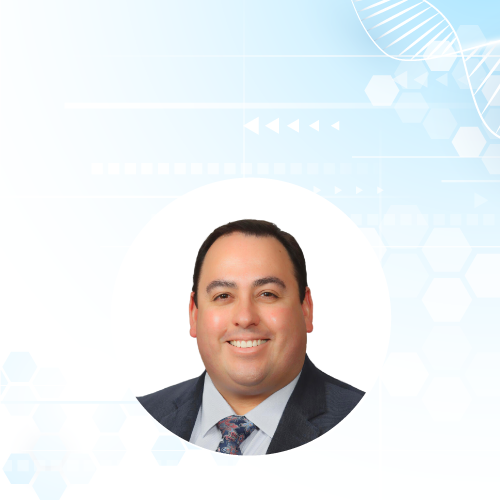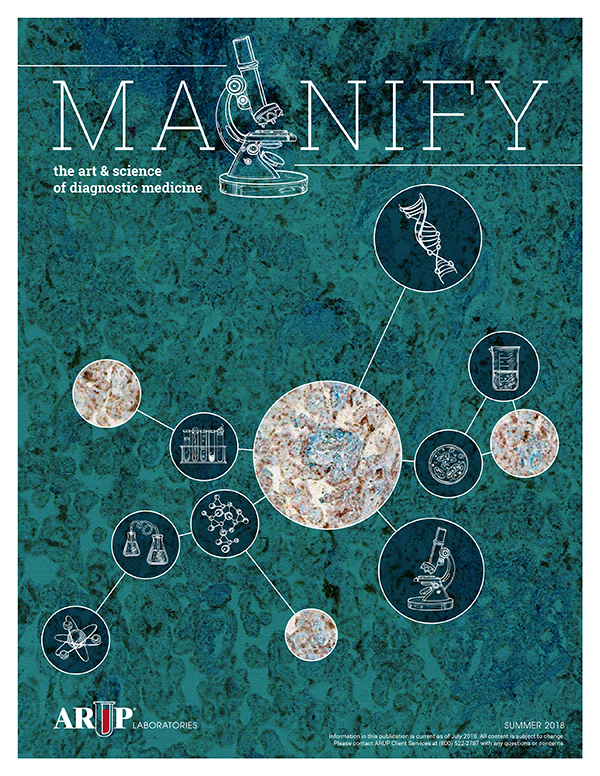ARUP Alumni: 40 Years of Training the Best and Brightest
David Grenache, PhD, D(ABCC), MT(ASCP), was working as an associate medical director at the University of North Carolina at Chapel Hill hospital laboratory in 2007 when he received a call. On the line was William L. “Bill” Roberts, MD, PhD, section chief of Chemistry and medical director of the Automated Core Lab at ARUP, a man whom Grenache knew only by his reputation in clinical pathology.
David G. Grenache, PhD, D(ABCC), MT(ASCP)

Chief Scientific Officer and Laboratory Director of the Core Laboratory, TriCore Reference Laboratories
Clinical Professor of Pathology, University of New Mexico
ARUP Medical Director of Special Chemistry Lab: 2007–2017
Challenge Yourself and You Will Grow
David Grenache, PhD, D(ABCC), MT(ASCP), was working as an associate medical director at the University of North Carolina at Chapel Hill hospital laboratory in 2007 when he received a call. On the line was William L. “Bill” Roberts, MD, PhD, section chief of Chemistry and medical director of the Automated Core Lab at ARUP, a man whom Grenache knew only by his reputation in clinical pathology.
Grenache didn’t know much about ARUP and wasn’t looking for a job, but he was intrigued when Roberts told him about an opportunity to run the Special Chemistry Lab as its new medical director. When he told his then-partner that night about speaking with Roberts, his partner asked, “Are you going to go?” Grenache replied, “Of course not! We can’t live in Utah. They don’t let gay people in Utah.” His partner encouraged him to give it a chance. “Well, don't you think that you should see it before you judge it?”
The visit to ARUP left Grenache highly impressed by the lab operations. With his partner, he decided to take the leap and pursue the opportunity. He saw it as a challenge professionally and personally, and has always tried to live his life with this personal philosophy: Challenge yourself and you will grow.
Now, years later, when Grenache looks back at this moment, he calls it the best career decision he ever made, thanks to the people at ARUP who influenced his career and allowed him to blossom: Roberts, Ed Ashwood (ARUP CEO from 2009 to 2015), and Carl R. Kjeldsberg, MD (ARUP CEO from 1992 to 2009), among many others.
In 2017, Grenache left ARUP for a new challenge as chief scientific officer of TriCore Reference Laboratories, a regional clinical lab serving the state of New Mexico.
When he reflects on his time at ARUP, Grenache remembers the feeling of being part of a community that rallied behind a single mission and vision, working toward continuous improvement and offering high-quality lab services.
“Despite the often intense and serious nature of the work we did at ARUP, one could still always find a way to laugh and have fun,” he said.
Brian Shirts, MD, PhD

Director of the Institute for Public Health Genetics and Associate Professor in the Department of Laboratory Medicine and Pathology, University of Washington
ARUP Clinical Pathology Residency: 2008–2012
ARUP Molecular Genetic Pathology Fellowship: 2010–2011
ARUP Assistant Medical Director of Informatics: 2009–2012
The Perfect Combination
In 2008, Brian Shirts, MD, PhD, had just received his doctoral degree in human genetics from the University of Pittsburgh and was looking for a clinical pathology residency. ARUP Laboratories kept coming up again and again.
Shirts was no stranger to Utah. He had grown up in the state and earned a bachelor’s degree in biology from the University of Utah. This combination of familiarity and the opportunity to train at one of the top laboratories in the country made the decision to accept a residency obvious.
Once at ARUP, he worked with Medical Director Brian Jackson, MD, MS, in informatics and laboratory test utilization management. The projects that had the most impact on Shirts were about how laboratory test results, including genetic test findings, can best be communicated to physicians and patients.
The principles he learned from Jackson inform his current work in familial cascade testing at the University of Washington. If an individual tests positive for a genetic condition, best practice calls for the individual to inform relatives so they also can be tested. This is cascade testing.
In reality, however, cascade testing doesn’t always happen, so people who could benefit from the information aren’t informed.
“In the best interest of patient care, healthcare providers are obliged to better communicate about hereditary cancer risk and family outreach,” Shirts said.
This conviction led him to start a research project called ConnectMyVariant, which is based on the idea that if two people have the same pathogenic variant, they have a 90% chance of a common ancestor. Shirts’ project is now a nonprofit and helps individuals with variants understand how to expand the outreach to connect with others who may need testing. He credits his time at ARUP for providing him with a productive, exciting, and interesting combination of academic and high-throughput reference laboratory work that he hasn’t found anywhere else in the country.
“I really appreciated there was the culture [at ARUP] of patients first, and doing things that are right for the patient.”
Alice To, alice.to@aruplab.com
Christopher Garcia, MS, MD

Medical Director, Division of Computational Pathology and AI, Mayo Clinic
ARUP Informatics Residency: 2013–2014
ARUP Assistant Medical Director of Informatics: 2012–2014
Implementing Clinical Artificial Intelligence With a Patient-First Focus
Christopher Garcia, MS, MD, now medical director of Mayo Clinic’s Division of Computational Pathology and AI, took an unexpected turn toward medicine after he volunteered at a hospital emergency room (ER) in 2004. He had planned to build a career in web development and graphic design before his ER experience reshaped his priorities and inspired him to pursue a career in medicine long term. He remembers how good he felt at the end of each day he volunteered, knowing that he had helped someone.
Shortly after Garcia started medical school at the University of Illinois College of Medicine, he realized that he could combine his passion for web development with his desire to help patients by pursuing a career in health informatics.
In 2013, Garcia had the opportunity to study and practice health informatics at ARUP as a resident. While at ARUP, he worked with Medical Director Brian Jackson, MD, MS, on many applications, including Analyzing Test Ordering PatternsTM (ATOP®), a custom reporting tool designed to help clients use patient data to enhance lab test utilization and patient care, and ARUP Consult®, a clinician’s guide to diagnostic testing.
As part of a student project at ARUP funded by the University of Utah Department of Pathology, Garcia developed a digital pathology platform that clinicians and students could use to upload deidentified slides and collaborate. This platform has been used globally, and as the primary contact to field user questions, Garcia received inquiries from people all around the world about the platform well after he left ARUP.
Garcia has since held positions at ARUP, Philips, Labcorp, and Mayo Clinic and said that ARUP played a vital role in cementing his patient-first values. “High quality and putting the patient first have colored the rest of my career. I bring that with me everywhere I go,” he said. “It’s helped me be a strong patient and physician advocate out in corporate America.”
At Mayo Clinic, Garcia leads teams that are developing and implementing artificial intelligence (AI) in the clinical laboratory. As a medical director, he vets incoming projects, provides guidance, and offers solutions. His teams are expanding and taking on a variety of AI/machine learning (ML) projects.
Applications of AI/ML in medicine are far reaching and rapidly growing. Predictive AI analytics for cancer diagnosis and interpretation of the composition of kidney stones are some examples, Garcia explained. With each project, his team works hard to ensure that all solutions mitigate bias and are safe, high quality, and appropriately managed. He is excited about how AI/ML can be used to help patients, and is happy to have carried the knowledge and ethical awareness he acquired at ARUP to other healthcare companies.
Ryan Craig, MD, PhD

Residency Program Director and Assistant Professor, Tulane University School of Medicine
ARUP Anatomic/Clinical Pathology Residency: 2014–2018
ARUP Hematopathology Fellowship: 2018–2019
Paying It Forward: From ARUP Resident to Tulane Residency Director
In 2008, Ryan Craig, MD, PhD, now Tulane University School of Medicine residency program director and assistant professor, took a long camping trip through many of Utah’s national parks. As someone from Louisiana, he had never seen anything like them. “I fell in love with the geography and the scenery, coming from Louisiana, where there’s no snow, no mountains, none of that stuff,” he said.
When he went back home and began missing the mountains, Craig knew he had to return. As a medical student at Louisiana State University, he knew the most efficient way to move to Utah would be to find a residency or fellowship program in the state and continue his education. After researching medical schools in Utah, he decided to apply for a residency at ARUP.
Beyond its proximity to natural beauty, ARUP offered Craig the opportunity to learn the ropes of pathology and conduct his own research with the help of expert medical directors. He also knew that pathology would be the best route for him because he could “be involved with patient care while pushing the frontiers of medicine through research and clinical trials.”
Quickly after starting his residency, he knew he was in the right place. “I felt lucky that I was able to train somewhere that has such an extensive test menu, case volume, and talented faculty members with lots of specializations. It was an encouraging place to be.”
Craig appreciates ARUP’s focus on leadership training for its residents and fellows and attributes his successful career progression to this training. He learned how to collaborate with others and lead teams in a way that he had not learned through any other schooling. After returning to Louisiana and accepting a faculty role at Tulane, he quickly rose to a leadership position. Now, he holds multiple appointments at Tulane, including as director of its residency program.
His daily responsibilities include assisting with immunology research and counseling residents. He remembers his time as a resident fondly, and his favorite part of his job is showing the same support to his residents that he received at ARUP.




